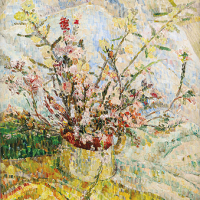GRACE COSSINGTON SMITH Wildflowers in Jug

‘…Australian wildflowers are quite on their own, they are the most lovely things that we have and their colour… is soft, brilliant colour like our atmosphere, which is very wonderful. I’m particularly fond of the Australian bush with its marvellous soft colour and the colour of the gum trunks themselves, the pinks and the whites, the reds and greys and blacks.’1
Grace Cossington Smith is widely remembered as one of Australia’s great modernist painters. She is also undoubtedly one of Australia’s most loved and significant female artists. Her wonderful depictions of the construction of Sydney Harbour Bridge from the late 1920s are nothing short of iconic and symbolised the coming of a new and modern Australia. When viewed in conjunction with her new vision for both still lifes and scenes of domestic life, it is little wonder Cossington Smith was regarded as one of the leading exponents of early twentieth century art in this country.
Born in 1892, Grace Cossington Smith was the second of five children to Ernest and Grace Smith. In 1910 at the age of 18, she began drawing classes at Antonio Dattilo-Rubbo’s atelier in Sydney where her work benefited from Signor Rubbo’s insistence on the importance of drawing. In 1912, Cossington Smith travelled with her father and sister Mabel to England and undertook art classes at Winchester Art School. She would later reflect she was already fascinated with the unique Australian light; ‘I didn’t want to stay in England… as a country, I would rather live in Australia because it interests me from my art point of view… Australia is absolutely wonderful, the country, the animals, the flowers, everything… [The light] is more intense and brilliant.’2
By 1914 she returned to Sydney and to Dattilo-Rubbo’s atelier to begin painting in oils. By all accounts Dattilo-Rubbo was an inspiring teacher, directing his students to consider the revolutionary work of Vincent Van Gogh, Paul Gauguin and Paul Cézanne and encouraging them to push the possibilities of colour use within their own work wherever possible. It was these theories on colour and light which she found particularly engaging. Cossington Smith’s, The Sock Knitter, 1915 is widely regarded as Australia’s first post-Impressionist painting. Her growing interest in colour is further evidenced by the fact that during this time Dattilo-Rubbo gave her the nickname ‘Mrs van Gogh’ in reference to one of her paintings on the theme of Van Gogh’s yellow room.3
From the late 1930s, there was a distinct change in Cossington Smith’s work. She frequently joined artistic friends including Helen Stewart and Enid Cambridge, to paint Sydney and regional areas of New South Wales. Increasingly there is a shift from her earlier vivid colours and non-representational palette towards a more earthy and quintessentially Australian palette. In 1931, her brother married Mary Yarwood, and she visited the Yarwood’s property near the Southern Highlands. Here she was struck by the parched landscape and went to lengths to capture the colour and mood. She became enchanted with Australian wildflowers and was keen to utilise her new found palette to evoke a sense of the unique Australian light and colour in her work. In the same year, Cossington Smith was also devastated by her mother’s passing and the transience of life is almost certainly reflected in her tender depictions of flowers.
Wildflowers in Jug is one of a number of works featuring native flower arrangements undertaken by Cossington Smith. Art critic Deborah Hart observes ‘part of the success of Cossington Smith’s wildflower paintings is the combination of structure with a feeling for the looseness and randomness of the plants themselves.’4
A larger related painting by the artist, Wildflowers, is in the collection of the Art Gallery of New South Wales. Her flowers here again appear to be more rustic than any florist’s posy. Here Cossington Smith has a mix believed to be featuring yellow wattle blossom [Acacia pycnantha]. The single most important element as far as Cossington Smith was concerned was to capture the light and the subtle nuances of colour. She would later reflect, ‘My chief interest I think has always been colour, but not crude flat colour. It must be colour within colour, it has to shine; light must be in it’.5
Australia’s other great female modernist painter, Margaret Preston was similarly concerned with portraying a uniquely Australian vision. When awarding Cossington Smith the Mosman Art Prize in 1952, Preston’s adjudication reveals the unifying sentiment both artists were trying to achieve; ‘This country must have an Art of its own… quite distinctive and typical of Australia…’6
However Cossington Smith’s floral works are not just a proud tribute to the native flora peculiar to this country, they are also a master colourist’s response to the unique light found in Australia and a captivating product of a changing time.
Footnotes
1. Smith, G.C., in 1965 interview with de Berg, H., cited in Hart, D.,Grace Cossington Smith, Touring Retrospective Catalogue, National Gallery of Australia, 2005, p.65
2. Smith, G.C., interview with Roberts, A., 29 January 1970, cited in Hart, D., Grace Cossington Smith, Touring Retrospective Catalogue, National Gallery of Australia, 2005, p.2
3. Campbell, J., catalogue introduction, Antonio Dattilo-Rubbo, retrospective exhibition, Manly Art Gallery & Museum, 1980
4. Hart, D., Grace Cossington Smith, National Gallery of Australia, retrospective exhibition catalogue, 2005, p.65
5. Interview with de Berg, H., 1965, National Library of Australia
6. Preston, M., cited in Hart, D., Grace Cossington Smith, National Gallery of Australia, retrospective exhibition catalogue, 2005, p.65-66
Marina Bromley BA (Hons)